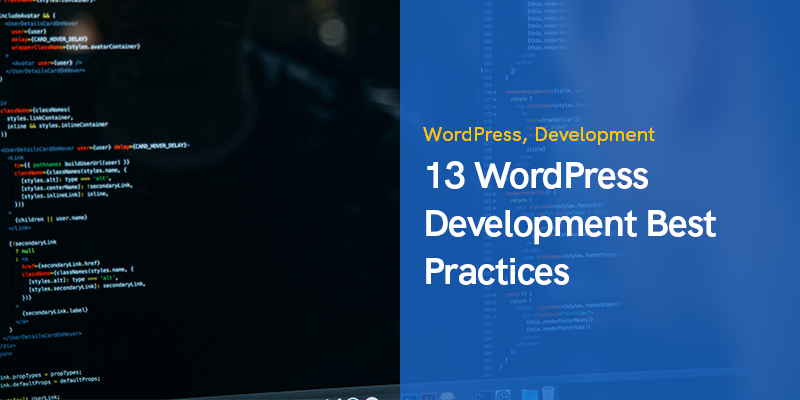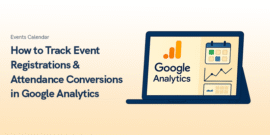
13 WordPress Development Best Practices
Building an excellent website ought to be a top priority for any business looking to build a profitable online presence.
In the world of websites, WordPress has rapidly gained popularity. So much so, that you will find around 40% of websites on the Internet being powered by WordPress.
It is also known for dominating the content management system (CMS) market with more than 60% share. This CMS platform makes it possible to build some remarkable websites with the help of an AI coding assistant.
WordPress offers you a dashboard with a simplified interface to create web pages, customize designs, and add content that entices, entertains, and educates your audience and prospects.
However, for beginner-level developers, even the simplest interfaces can often seem terrifying. Sounds relatable?? If yes, you are on the right page.
In the following sections, we will be talking about a few WordPress-specific practices that will help you get started. Adhere to these guidelines and you will not be lost even if it is your first time creating a WordPress website.
Best Practices For Website Designing
Website design is one of the major aspects of the development process.
Website design is not just aesthetics. Your web design should strike a balance between your business goals, user needs and experience, and the content you are adding. To ensure your content is value-driven and helps your website attain visibility, you should consider investing in a website checker.
I know developers love getting their hands dirty with codes but the refined structure of your codes won’t matter if the layout of your final website is spoiling the user experience. Thus, it is important to keep these practices in mind.
Prioritize Responsive Design
It is crucial for your website to be compatible with every screen size, platform, orientation, and device to enhance user experience. This can be effectively achieved with responsive web design services.
Mobile phones are responsible for around fifty percent of the global internet traffic. It is, hence, crucial for you to ensure your website functions flawlessly across different devices.
It is true that it might require hours of testing and fixing but if you overlook this design component, you can bid adieu to almost one-third of your traffic.
Or, if you are short on time, you can always use a responsive WordPress theme. They will save you time, make your websites look aesthetically pleasing, and also give you an SEO advantage since mobile-friendly websites rank higher on Google.
Some of the best examples of responsive themes are Divi, Hestia, Tusant, and Neve.
Keep up With the Trends
Very common. Very obvious. And yet, many avoid putting in extra efforts to understand major trends in the current times. Individuals tend to depend on their unconscious familiarity with the latest happenings that they pick during their daily browsing habits.
It’s vital for you to understand and leverage the power of visual engagement for your web development. All you need to do is simply follow a few design rules and you’re home. Staying with the trend is one of them.
Keeping up with the trends will help you grow and also improve your design sensibility overall.
Leverage White Space
Make white spaces your best friend. It can be a nightmare for your users if your website resembles an old newspaper, filled with text. Sometimes, you need to prioritize aesthetics over efficiency.
When you leverage white spaces on your website, your users will be naturally attracted to the information that you want them to see.
Apart from highlighting a particular section of your website, white spaces will also make the pages look more sleek and readable. Add these practices to your list of priorities and your website will instantly look way more polished.
Focus on Typography
Fonts and typography are an integral part of website design. Open-Sans or Times New Roman are thus not the only fonts that you see on the web.
There is an unlimited set of fonts that’s available now. Gone are the days when a lack of fonts held back the developers. Now, it all depends on how much time are you willing to spend to find the perfect fit.
Your font should keep your content in focus and look like a part of your overall design. Pairing different fonts is an art and is a decision that needs to be taken after a careful thought process.
Ensure Easy Accessibility
To enhance the user experience, make your content easily accessible. This is especially true for those finding ways to reduce website bounce rates and make users linger on the website for a longer period of time.
As a website designer, it is your responsibility to structure the website in a way that makes it look more appealing. Be sure to avoid poor layouts, poor-quality content, and lack of search options.
Everything should be navigable and labeled clearly. Your design should allow your users to be prompt in determining that your website contains all the information they seek.
Best Practices For Beginner-Level Developers
With these practices in mind, you will have an understanding of how you can ensure you are starting out on the right note.
Follow WordPress Coding Standards
When you are developing tools for WordPress, make sure you are always following the coding standards. This is for two main reasons – to ensure readability and to minimize common errors.
The WordPress coding standards have been developed by programmers after several trials and errors. They are known to maximize business success as well as security.
Initially, it might get a little difficult to switch your coding style but after relentless practice, you will realize that these coding standards are much easier to write, read, and maintain.
There are four main languages that are used include HTML, JavaScript, CSS, and PHP. Go through all the coding standards from attributes to space usage of your choice of language to ensure you are on the right track.
Carefully Select Plugins and Themes
WordPress plug-ins can help you build a powerful website. However, add-ons can also slow down your website and threaten your security. It is crucial to choose those third-party plugins that are frequently upgraded.
When your plugins are getting updated regularly, the chances of you facing any compatibility issues with the upgraded versions of WordPress are less.
Have a dedicated resource to conduct an audit of all the WordPress add-ons that you are using. Your plugins should be checked for the latest updates and how well they are performing.
During this audit, you should also uninstall the plugins you are not using. It will help minimize the risk of infecting your website with malware.
Ensure Security
Cybercrime is a serious threat. You should take preventive measures to ensure your website is safe at all times.
One of the ways to avoid such threats is by choosing the username and password that are uncommon and not easy to deduce. If you keep your username as Admin, it’s not difficult to guess.
There are also additional security plugins like Sucuri, WPScan, and BulletProof Security that you can install as pre-emptive measures. These plugins have features like keeping a track of fake login attempts, spam comments, user activity, blacklisting, and blocking attackers that keep your data protected.
Prioritize User Experience
If you are building a website you obviously want website visitors.
When working on developing the interface of a website, keep the user experience in focus. Take empathetic steps to ensure what you are offering will fit the needs of your user. If you want your customers to easily navigate through your website and reach the end of the funnel, make sure there are no obstacles.
If you’re not sure about user needs, you can always ask them. User research is a crucial part of any development project. You can also invite a novice user from your target audience to test the website for you. This way, you can see your work in a new light and make changes accordingly.
Opt for Child Themes and Custom Plug-Ins
It is highly recommended to not touch the codes of any third-party plugins. If you wish to, let’s say, add new functions to a theme, make sure you are creating a duplicate ‘child theme’, instead of directly changing the codes of third-party assets. Otherwise, you risk overwriting your custom code in the future when you update it.
You can also add a custom plugin to make it easier for you to add your desired functionality. For instance, you can create a plugin to add a different User Role.
The main reason for adding functions as plugins rather than themes is the ease of switching between different themes without hampering the functionality.
Ensure Code Reliability
There are a number of best practices that developers have created to ensure the longevity, maintainability, and reliability of codes. Features that are quite crucial.
Longevity and maintainability are directly proportional to reliability. How? If your codes are not sustainable when the original creator is not around, the chances of your project failing are high since you won’t have anyone else to control continuity and ensure maintenance.
As a developer, it is your responsibility to go beyond the basic requirement and create robust as well as readable codes.
The best way to start is by creating a plan. It should consist of all the requirements that the problem statement reflects. Your ideal plan will include organized folders for all images, Js files, etc., a method to ensure easy cross-platform adaptability, and a system for codes that you can reuse.
Also, make sure your codes are easy to read. Work on the naming conventions for functions, classes, and variable names that are precise.
Make Codes Flexible
Keeping a check on updates and making the required changes to your codes consistently is what will help you avoid having an outdated website. Ensuring flexibility of codes is, hence, vital.
You should be able to edit your codes whenever needed, leaving you enough room to grow.
For this, use relative URL paths wherever you get a chance. This will make sure that you won’t need to edit all your codes if you plan on changing the site URL. It’ll save plenty of time on your hands.
Ensure Code Spacing
Spacing decisions can undoubtedly make a huge difference in readability.
Functionally, spacing rules don’t really differ much in codes. Let’s take a look at the space usage rules that are provided in the WordPress PHP Coding Standards.
- Add spaces after commas and on either side of comparison, assignment, logical, and string operators.
- Both sides of the opening and closing parentheses should have spaces.
- Avoid whitespaces towards the end of the code.
- It is preferable to use no closing PHP tag.
When you follow these coding standards, your codes will be more legible.
Conclusion
To wrap it up, building a website requires you to be a developer as well as a designer. It is only after getting an understanding of both will you be able to work towards enhancing the user experience, which is the ultimate goal.
Make sure you adhere to the coding standards, keep up with the trends, and ensure readability of your codes as well as web content to be on the right track when developing your skills.
Recommended Posts

10 Must-Have WordPress Plugins for Every Successful Website in 2025
September 11, 2025
I don’t know how to thank you. I stick to whatever you had mentioned in this article and established my online shop. You REALLY helped me in this way and I’m thankful for that.
Great article Thanks a lot.
I actually got some problems in the security title. Anyone could elaborate?
I would say that It is a very one of the best blogs and guide regarding website designing and how to do practice for developing an efficient website which can work smarter, better, and faster.
Thanks to put so much for effort and time.
A very informative blog.
Keeping up with the trends is a good option but it should never be prioritized.



I really like reading through a post that can make men and women think. Also, thank you for allowing me to comment!